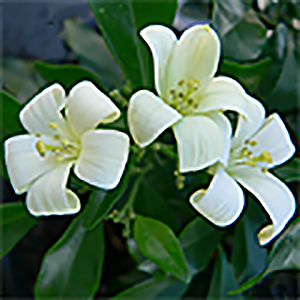Murraya paniculata is commonly known as ‘Orange Jasmine’, ‘Orange Jessamine’ and Mock Orange’. Being such an easy care plant it is no wonder it is so widely grown.
Regarded as winter hardy in zones 10 – 12, this is a plant that can also be grown indoors given good conditions

Grown outdoors it makes an easy care low growing hedge, spacing should be at around 20 inches (50cm) apart for a low growing hedge and 20 inches for a taller hedge (2m).
Although some of these plants do produce small red fruit, they are not really edible. One issue with the plant is that they can self seed depending on variety, this makes them a potential weed problem
If you are growing them outdoors you should be looking for the sterile varieties that are now becoming available for sale. It is the foliage and the creamy white citrus scented flowers that are produced through summer that we grow this plant.
A few dwarf varieties have recently been released, even better for low hedges and excellent for smaller gardens. And yes you could grow Murraya paniculata indoors if you were so inclined.
You would need a warm sunny position and a well drained humus rich soil. A little regular pruning would keep the plant to a reasonable size
How to Grow Murraya paniculata
Murraya are related to Citrus and will respond with similar care.
- If you grow them in containers and overwinter indoors you need to follow a few basic steps.
- Use a soil that is formulated for citrus trees in containers.
- It should be free draining yet retain some moisture. One of the big problems with container grown plant is letting the soil dry to the point of desiccation.
- Fertilize with a citrus fertiliser in early spring, water well before applying, and again after.
- Make sure that when indoors the light is strong and filtered.
- As soon as spring comes around, and the frosts are over, more the container to a morning sunny position on a patio or balcony.
- In cooler zones consider using Choisya ternata instead. It looks similar, has fragrant flowers and is hardier in cooler areas.
Care Details
- Sun/Light
Good sun is essential for flowering and good foliage colour, however very hot afternoon sun can cause leaf burn, so a little afternoon shade can be used. - Soil
A fertile soil is essential for good foliage colour, sandy poor soils lead to yellowing foliage. Dig soil over well before planting , shallow poor soils are not suitable.
Poorly drained soil should be avoided as they cause root problems. - Watering
Once established this a reasonably drought tolerant plant, however in long dry periods extra water will be required.
A good layer of mulch around the plant will help retain moisture and provide a cool root run. - Fertiliser
In good soil, an application of slow release organic fertiliser in spring should be sufficient. If leaves begin to yellow, some additional liquid fertiliser in summer may be beneficial. - Planting Distance
For hedges plant at around 1.5 – 3 ft (.5 – 1m) apart for a good dense hedge.
Pruning
This will differ if you are growing indoors, or outdoors.
Outdoors Murraya paniculata is fairly fast growing, especially in the warmer zones.
You can use electric hedge trimmers. or hand shears. To keep the plant formal. you may need to prune once a month during the growing season. Stop pruning in Fall and do not prune through winter in cooler zones.
Summary Details
- Botanical name – Murraya paniculate
- Common Names – ‘Orange Jasmine’, ‘Orange Jessamine’ and ‘Mock Orange’.
- Origins – South East Asia and Australia
- USDA Zones – 10 – 11
- Position – Full sun to a little shade.
- Soil – Humus rich fertile soil for good growth
Height – To around 9ft tall, easily pruned. - Width- To around 6ft in width over time.
- Flowers – White and fragrant
- Flowering time – Spring through summer into Fall
- Frost tolerant – No
We are Asked
Why is my Orange Jasmine not flowering
Usually due to lack of light or too much nitrogen in the fertiliser.
Is Orange Jasmine Invasive.
Yes, especially seed grown plants. Look for named cultivars that do not seed.
Is the root system invasive?
Although the plant does have a deep tap root, the root system is not considered invasive.

